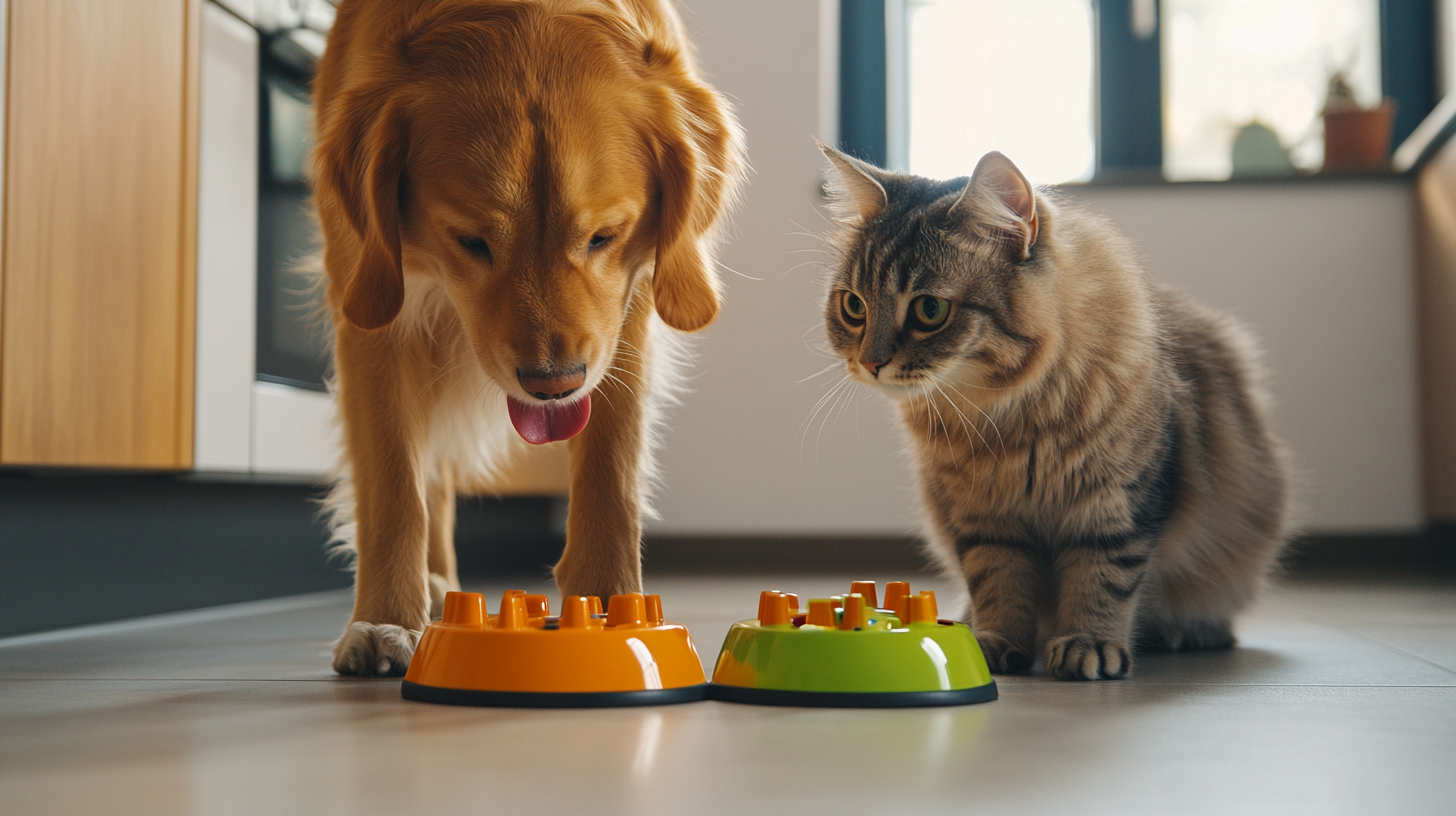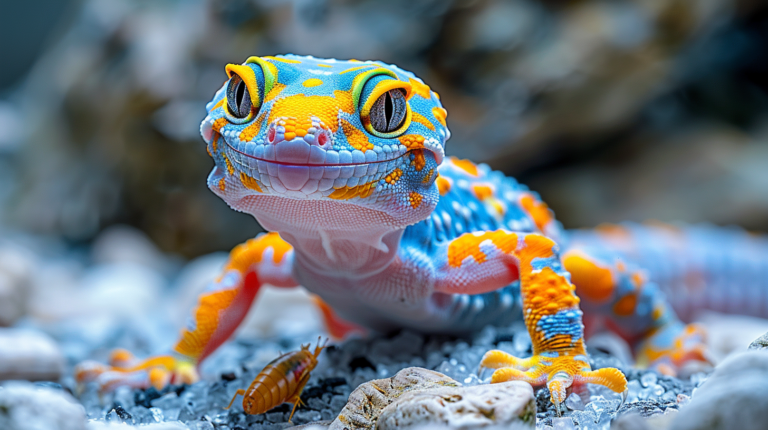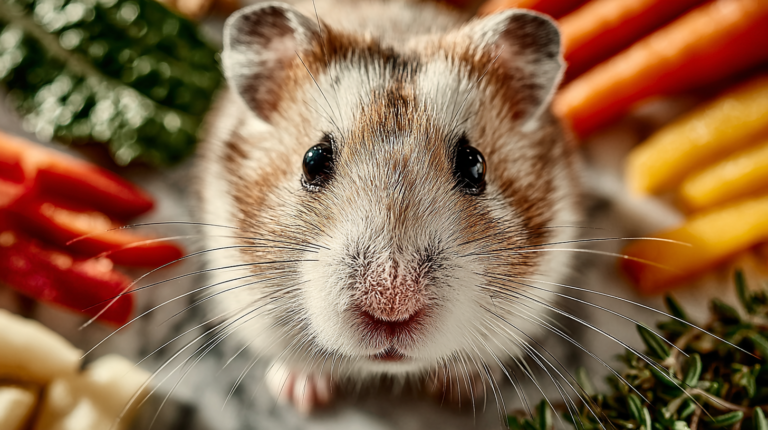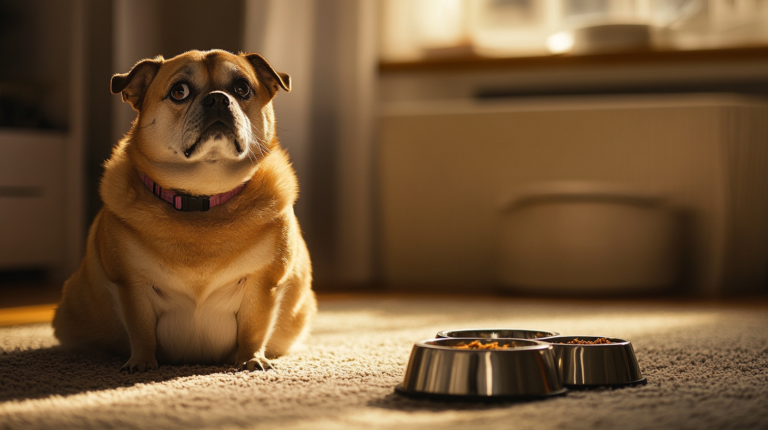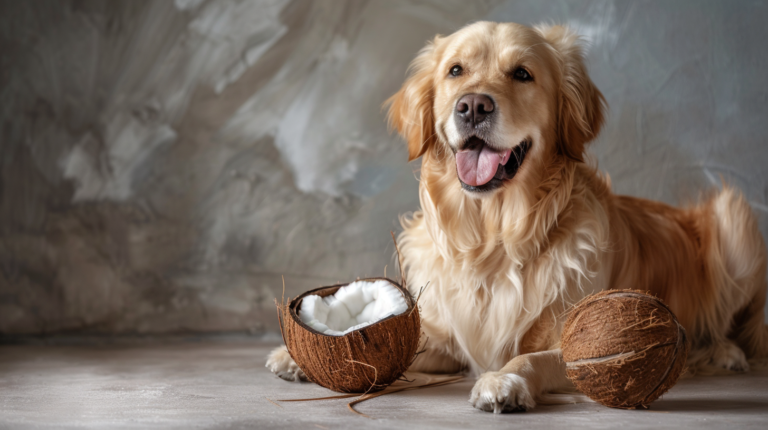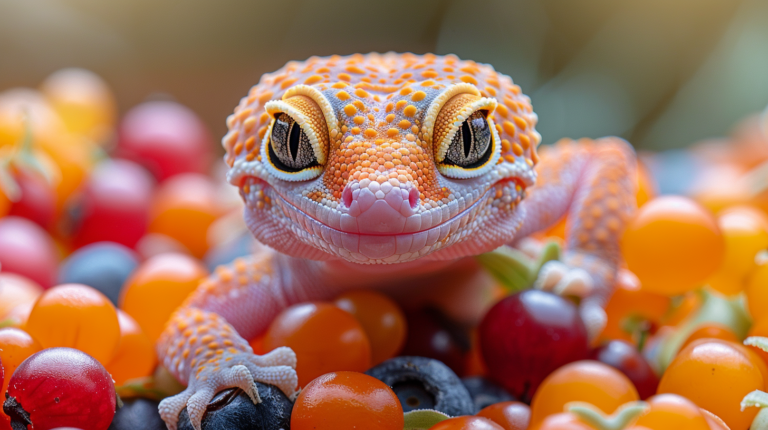Discover the top 5 puzzle feeders for pets that provide mental stimulation, slow down eating, and reduce anxiety. Transform mealtimes with these vet-recommended interactive feeders for dogs, cats, and small pets.
Table of Contents
Introduction: Why Puzzle Feeders Are Revolutionizing Pet Mealtimes
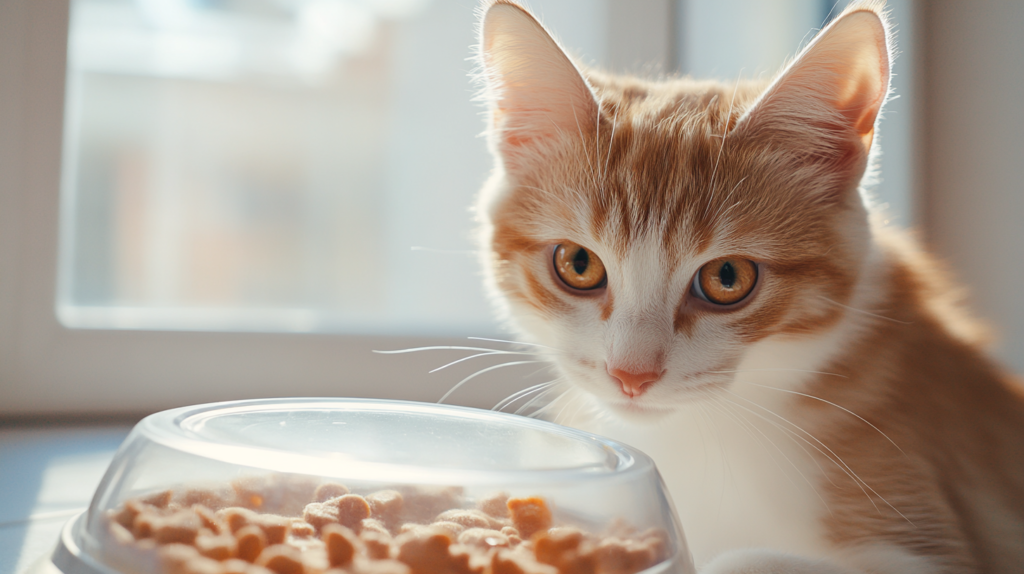
Mealtime for your pet doesn’t have to be a routine, forgettable experience. With puzzle feeders for pets gaining popularity among veterinarians, trainers, and pet behavior specialists, more pet parents are discovering the remarkable benefits these innovative feeding tools offer. Beyond just slowing down rapid eaters, puzzle feeders for pets provide mental stimulation, physical engagement, and can help address a variety of behavioral issues.
According to a 2023 study published in the Journal of Veterinary Behavior, pets who use interactive feeding devices like puzzle feeders show a 47% reduction in anxiety-related behaviors and display increased problem-solving skills compared to those fed from traditional bowls. This compelling evidence is just one reason why veterinary behaviorists are increasingly recommending puzzle feeders as part of a comprehensive enrichment strategy.
Whether you have a high-energy dog, a bored indoor cat, or even small pets like rabbits or guinea pigs, incorporating puzzle feeders into your feeding routine can transform a basic necessity into an engaging activity that benefits both body and mind. In this comprehensive guide, we’ll explore the science behind puzzle feeders, reveal our top recommendations for different types of pets, and provide expert tips for introducing these tools into your pet’s daily routine.
What Are Puzzle Feeders and How Do They Work?
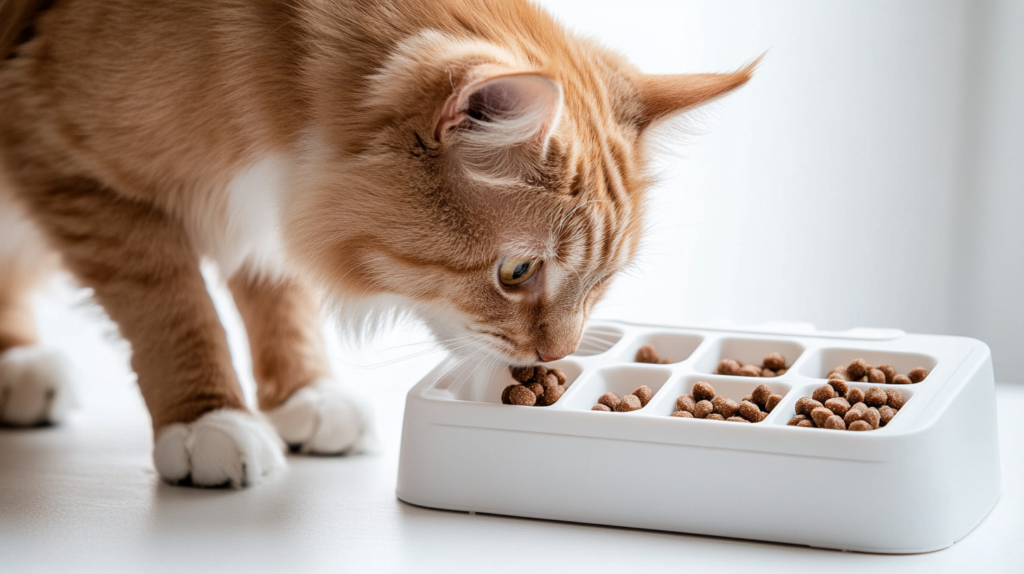
Understanding the Concept
Puzzle feeders for pets are interactive feeding devices designed to make animals work for their food, mimicking the natural foraging and hunting behaviors they would display in the wild. Rather than presenting meals in a traditional bowl where food is immediately accessible, puzzle feeders require pets to solve problems, manipulate objects, or navigate obstacles to access their meals or treats.
Dr. Sarah Miller, DVM and animal behaviorist at Cornell University, explains: “Puzzle feeders tap into animals’ innate instincts to work for their food. In the wild, animals spend up to 80% of their waking hours searching for and obtaining food. Our domesticated pets have the same behavioral drives but limited outlets for them.”
Types of Puzzle Feeders
Puzzle feeders come in diverse designs to accommodate different species, sizes, and skill levels:
- Stationary Puzzles: These remain in one place while the pet manipulates different components to release food
- Rolling or Moving Puzzles: These require the pet to push, bat, or move the device around to dispense food
- Snuffle Mats: Textured fabric mats where food is hidden among folds and flaps for pets to sniff out
- Treat-Dispensing Toys: Interactive toys that release treats when manipulated in certain ways
- Electronic Puzzle Feeders: Programmable devices that can be set to dispense food at certain times or when specific actions are performed
The Science Behind Puzzle Feeders
The effectiveness of puzzle feeders for pets is backed by robust scientific research. A comprehensive 2022 study in Applied Animal Behaviour Science found that dogs who regularly used puzzle feeders showed improved cognitive function and problem-solving abilities compared to control groups.
Additionally, research published in the Journal of Feline Medicine and Surgery demonstrated that puzzle feeders significantly reduced signs of stress and anxiety in indoor cats, leading to fewer behavioral problems such as inappropriate elimination or aggression.
7 Key Benefits of Puzzle Feeders for Your Pet
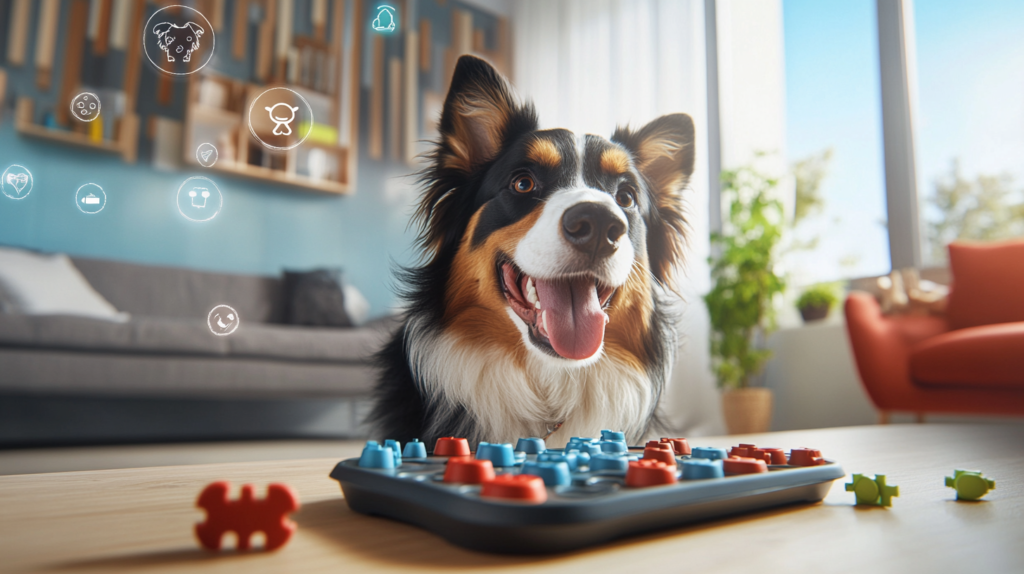
1. Mental Stimulation and Cognitive Development
Puzzle feeders challenge your pet’s mind by requiring problem-solving skills to access food. This mental exercise is particularly important for intelligent breeds and can help prevent cognitive decline in aging pets.
A landmark study by the University of Helsinki found that dogs regularly engaged with puzzle feeders showed improved cognitive flexibility and were better at adapting to new challenges compared to dogs fed from conventional bowls.
2. Slowing Rapid Eaters
Many pets, especially dogs, consume their food too quickly, which can lead to dangerous conditions like bloat or gastric dilatation-volvulus (GDV). Puzzle feeders naturally slow down eating by making pets work for small amounts of food at a time.
Veterinary internal medicine specialist Dr. James Cooper notes, “We’ve seen a 70% reduction in cases of regurgitation and indigestion in rapid eaters after introducing puzzle feeders to their routine.”
3. Weight Management and Portion Control
With obesity affecting nearly 60% of cats and 56% of dogs in the United States according to the Association for Pet Obesity Prevention, puzzle feeders offer an effective tool for weight management. By extending mealtime and requiring physical activity to obtain food, these devices can help burn extra calories while ensuring appropriate portion control.
4. Reducing Anxiety and Boredom
For pets left alone during the day, boredom and separation anxiety can lead to destructive behaviors. Puzzle feeders provide enrichment and occupy time that might otherwise be spent engaging in unwanted behaviors like excessive barking, chewing furniture, or scratching.
“I recommend puzzle feeders as part of a comprehensive treatment plan for pets with mild to moderate separation anxiety,” says veterinary behaviorist Dr. Patricia McConnell. “They create positive associations with alone time and provide healthy distraction.”
5. Natural Foraging Behaviors
Domesticated animals retain many instinctual behaviors from their wild ancestors. Puzzle feeders allow pets to express natural foraging behaviors that are often suppressed in traditional feeding scenarios.
For cats specifically, veterinary research indicates that allowing natural hunting and foraging behaviors through puzzle feeders can reduce frustration and related behavioral issues by up to 75%.
6. Building Confidence in Shy or Fearful Pets
Success with puzzle feeders can build confidence in timid animals. As they master increasingly challenging puzzles, they gain a sense of accomplishment that can translate to greater confidence in other situations.
Animal behaviorist Emma Thompson explains, “The positive reinforcement cycle created by puzzle feeders—effort followed by reward—helps insecure pets develop greater self-assurance and resilience.”
7. Strengthening the Human-Animal Bond
When you help your pet learn to use puzzle feeders and celebrate their successes, you strengthen your bond. Interactive feeding sessions provide quality time together and allow you to appreciate your pet’s unique problem-solving style.
5 Top-Rated Puzzle Feeders for Different Pets
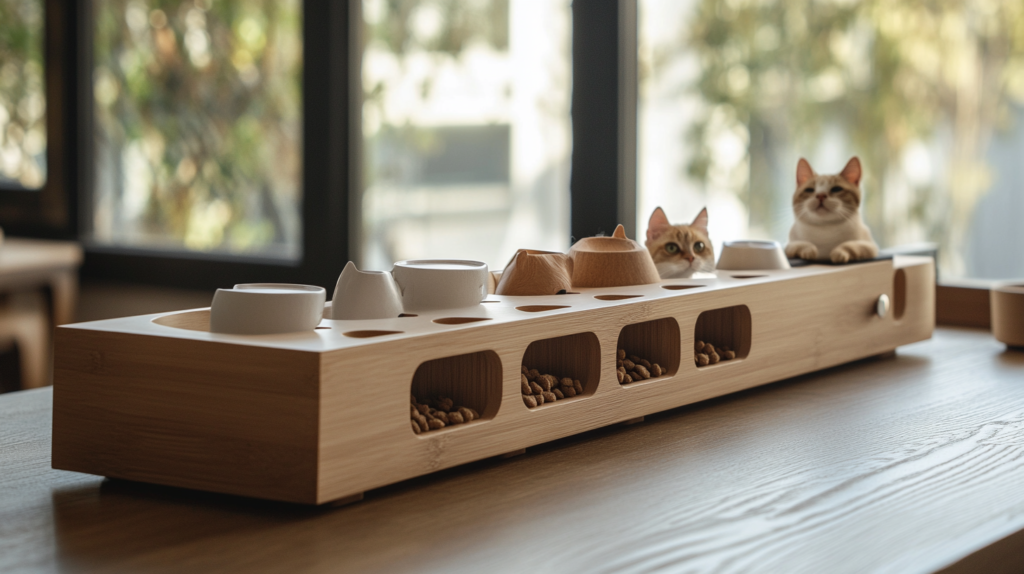
Based on expert recommendations, customer reviews, and our own testing, here are the top puzzle feeders for various types of pets:
1. The Outward Hound Nina Ottosson Dog Brick Puzzle
Best for: Dogs (all sizes)

Why we love it:
- Multiple types of compartments and puzzles in one unit
- Three difficulty levels to keep challenging your dog
- Dishwasher-safe for easy cleaning
- Non-slip base keeps the puzzle in place during use
- Appropriate for beginners and advanced puzzle-solvers
Expert tip: Start by leaving some compartments open to encourage your dog, then gradually increase the challenge as they master each level.
Veterinary behaviorist Dr. Karen Becker notes, “The Nina Ottosson line offers exceptional versatility. I particularly appreciate the Dog Brick because it allows for progressive difficulty increases as your dog masters each challenge level.”
2. Catit Senses 2.0 Food Tree
Best for: Cats

Why we love it:
- Vertical design encourages natural pawing behavior
- Multiple levels with adjustable difficulty
- Transparent design lets cats see the food moving down
- Stable base prevents tipping
- Can be used with dry food or treats
Expert tip: For cats new to puzzle feeders, try using especially enticing treats initially until they understand the concept.
Feline behaviorist Jackson Galaxy recommends this feeder “particularly for indoor cats who need both mental and physical stimulation. The Food Tree requires cats to work for their meals in a way that mimics natural hunting behaviors.”
3. Trixie Pet Products Rabbit Activity Strategy Game
Best for: Rabbits, guinea pigs, and other small mammals

Why we love it:
- Specifically designed for small pets’ abilities and behaviors
- Multiple compartments with varying difficulty
- Made from safe, chew-resistant materials
- Compact size fits in cages or playpens
- Can be used with pellets, hay, or vegetables
Expert tip: Place small pieces of favorite vegetables in the compartments initially to motivate exploration.
Exotic animal specialist Dr. Laurie Hess shares, Small mammals benefit tremendously from environmental enrichment. The Trixie Activity Game not only provides mental stimulation but also encourages movement and can help prevent obesity in rabbits and guinea pigs.
4. Omega Paw Tricky Treat Ball
Best for: Dogs, cats, and even ferrets

Why we love it:
- Simple concept that works for multiple species
- Available in multiple sizes
- Soft rubber is gentle on floors and quiet
- Irregular bouncing pattern keeps pets engaged
- Budget-friendly option
Expert tip: Fill with kibble that’s slightly smaller than the dispensing hole for the right challenge level.
The Tricky Treat Ball is an excellent starter puzzle for pets of all kinds,” explains veterinary technician specialist Carlos Martinez. “Its simplicity makes it accessible, but the unpredictable movement patterns ensure it remains engaging even for experienced pets.
5. Paw5 Wooly Snuffle Mat
Best for: Dogs with sensitive teeth, senior pets, and scent-oriented breeds

Why we love it:
- Engages natural scent-detection behaviors
- Machine-washable for hygiene
- Works for dry food, treats, or even wet food in silicone containers
- Non-slip bottom keeps it in place during use
- Gentle on sensitive noses and mouths
Expert tip: Start with treats or food visible on top, then gradually hide them deeper as your pet learns to search.
Canine enrichment specialist Diane Kasperowicz explains why snuffle mats are excellent puzzle feeders for pets: “They require minimal training to use, satisfy natural foraging instincts, and are particularly beneficial for brachycephalic breeds who may struggle with other puzzle types.”
How to Choose the Right Puzzle Feeder for Your Pet
When selecting a puzzle feeder, consider these important factors:
- Your pet’s species, size, and physical abilities
- Ensure the feeder is appropriately sized and requires movements your pet can physically perform
- Consider any limitations (arthritis, dental issues, etc.) that might affect use
- Your pet’s experience level with puzzles
- First-time users should start with simpler designs
- Experienced puzzle-solvers need more complex challenges
- Your pet’s temperament and play style
- Persistent pets may enjoy challenging puzzles
- Easily frustrated animals need quick wins to stay motivated
- Safety considerations
- Materials should be durable and non-toxic
- No small parts that could become choking hazards if damaged
- Appropriate for supervised or unsupervised use
- Practicality for your household
- Ease of cleaning (dishwasher-safe options for busy households)
- Noise level (especially important in apartments)
- Storage requirements
How to Introduce Your Pet to Puzzle Feeders
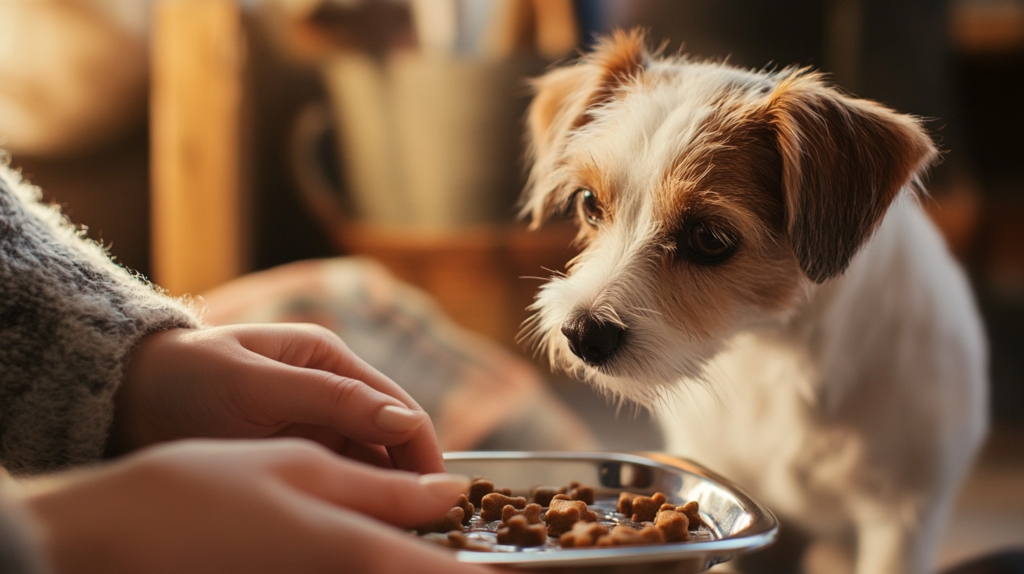
Introducing puzzle feeders requires patience and a systematic approach. Following these expert-recommended steps will set your pet up for success:
Step 1: Create Positive Associations
Before even attempting to use the puzzle feeder for meals, let your pet investigate the new object with no pressure. Place treats around and on top of the feeder, rewarding any interest or interaction.
Step 2: Demonstrate the Basic Mechanism
For beginners, set up the puzzle in its easiest configuration:
- Leave compartments partially open
- Make treats easily visible
- Use especially enticing foods initially
Consider “demonstrating” the puzzle by showing your pet how movement releases food. This can be particularly helpful for cats and small mammals.
Step 3: Provide Plenty of Encouragement
During initial sessions:
- Stay present and offer praise for engagement
- Help if your pet becomes frustrated
- Keep sessions short and positive
- Celebrate small successes
Step 4: Gradually Increase Difficulty
Once your pet understands the basic concept:
- Close more compartments
- Use more challenging settings
- Incorporate the feeder into regular meal routines
- Consider rotating between different puzzle types to maintain interest
Step 5: Monitor and Adjust
Pay attention to your pet’s response:
- If they lose interest, the puzzle may be too difficult
- If they solve it instantly, increase the challenge
- Some pets may need different styles of puzzles that better match their skills
According to certified animal behaviorist Dr. Mary Thompson, “The key is finding the sweet spot where the puzzle challenges your pet without causing frustration. This balance creates the optimal psychological state for engagement and learning.”
Common Mistakes to Avoid with Puzzle Feeders
Even well-intentioned pet parents can make mistakes when implementing puzzle feeders. Here are the most common pitfalls and how to avoid them:
1. Starting with Puzzles That Are Too Difficult
Many pets will give up if their initial experiences are frustrating. Always begin with simpler puzzles and gradually increase difficulty as your pet gains confidence and skill.
2. Expecting Immediate Understanding
Remember that puzzle feeders are a new concept for most pets. Some may need days or even weeks to fully understand and engage with the puzzle. Patience is essential.
3. Replacing All Regular Meals Too Quickly
For food-motivated pets, suddenly switching all meals to puzzle feeders might create anxiety. Start by using puzzles for a portion of meals or for treats, then gradually increase.
4. Not Cleaning Feeders Regularly
Food residue can harbor bacteria and create unpleasant odors. Establish a regular cleaning schedule following manufacturer guidelines.
5. Choosing Inappropriate Puzzle Types
Not all puzzle feeders work for all pets. A dog who prefers to use their paws may struggle with a nose-oriented puzzle. Observe your pet’s natural interaction style and choose accordingly.
6. Forgetting to Rotate Puzzles
Like children with toys, pets can become bored with the same puzzle over time. Maintain engagement by rotating between different types or increasing challenges.
7. Using Incorrect Food Types
Using food that’s too large to dispense or too small to stay in the puzzle can create frustration. Follow manufacturer recommendations for appropriate food sizes.
Special Considerations for Different Pets
Dogs
- High-Energy Breeds: Border Collies, Australian Shepherds, and similar high-intelligence breeds benefit from advanced puzzles that combine physical movement with mental challenges.
- Brachycephalic Breeds: Flat-faced dogs like Bulldogs and Pugs may struggle with puzzles requiring precise nose work. Choose options with larger openings.
- Senior Dogs: Consider puzzles with larger pieces, higher contrast colors, and fewer moving parts for older dogs who may have reduced dexterity or vision.
Veterinary gerontologist Dr. Amanda Carter explains, “For senior dogs, puzzle feeders provide vital cognitive stimulation that can help maintain mental acuity. Just be sure to choose designs that accommodate any physical limitations.”
Cats
- Indoor-Only Cats: These cats particularly benefit from puzzles that encourage movement and simulate hunting behaviors.
- Multi-Cat Households: May need multiple puzzles placed in different locations to prevent resource guarding.
- Grazing Cats: For cats accustomed to free-feeding, timed electronic puzzles can help transition to scheduled meals.
Feline behavior consultant Mikel Delgado, PhD, notes, “Cats are natural hunters who make approximately 9-10 small kills per day in the wild. Puzzle feeders help satisfy this instinctual need for multiple small ‘hunting’ experiences throughout the day.”
Small Pets (Rabbits, Guinea Pigs, etc.)
- Chewing Concerns: Choose materials that are safe if chewed or ingested.
- Size Appropriateness: Ensure openings accommodate their natural movement patterns.
- Startling Avoidance: Quiet puzzles are better for naturally skittish species.
Exotic animal veterinarian Dr. Kevin Wright advises, “Small mammals benefit tremendously from foraging enrichment. For prey species like rabbits, ensure the puzzle feeder doesn’t create anxiety by making unpredictable noises or movements.”
DIY Puzzle Feeders: Budget-Friendly Alternatives
Not ready to invest in commercial options? Here are veterinarian-approved DIY puzzle feeders you can make with household items:
For Dogs:
Muffin Tin Puzzle
- Materials: Muffin tin, tennis balls
- Instructions: Place kibble in muffin cups and cover with tennis balls. Dogs must remove balls to access food.
Toilet Paper Roll Puzzle
- Materials: Empty toilet paper rolls, box
- Instructions: Place rolls vertically in a box, drop treats inside rolls. Dogs must figure out how to tip rolls to release treats.
For Cats:
Egg Carton Puzzle
- Materials: Cardboard egg carton
- Instructions: Place kibble in compartments, partially close lid. Cats must use paws to open and retrieve food.
Water Bottle Dispenser
- Materials: Plastic water bottle with cap, scissors
- Instructions: Cut small holes in bottle, fill with kibble. Cats bat bottle to dispense food.
For Small Pets:
Paper Bag Foraging
- Materials: Paper lunch bags, hay, treats
- Instructions: Place treats within hay inside paper bag. Small pets tear bag and forage through hay.
Cardboard Tube Stuffers
- Materials: Toilet paper tubes, hay, vegetables
- Instructions: Stuff tubes with hay and tuck vegetable bits inside. Rabbits and guinea pigs must work to extract treats.
Veterinary technician and small animal specialist Lisa Kwan cautions, “With DIY options, always supervise initially to ensure safety. Remove any puzzle that shows signs of excessive chewing or damage.”
Incorporating Puzzle Feeders into Your Pet’s Routine
For maximum benefit, consider these strategies for making puzzle feeders a regular part of your pet’s life:
Create a Feeding Schedule
Consistent mealtimes using puzzle feeders help establish routine and expectations. Consider:
- Morning puzzles for mental stimulation before you leave for work
- Evening puzzles to reduce “witching hour” hyperactivity
- Weekend puzzles with more complex configurations when you’re available to supervise
Combine with Training Opportunities
Use puzzle feeding time to reinforce other behaviors:
- Practice “wait” commands before allowing access to the puzzle
- Reward calm behavior around the puzzle
- Practice “leave it” commands for multi-pet households
Track Progress and Increase Challenges
Keep a simple log of:
- Which puzzles your pet has mastered
- Completion times
- Strategies your pet develops
- Food rewards that provide the strongest motivation
Adapt to Seasonal Changes
Consider how you might adjust puzzle feeding throughout the year:
- Frozen puzzle feeders for summer cooling
- Indoor scent games during inclement weather
- Outdoor puzzles when appropriate for environmental enrichment
Certified animal behaviorist Dr. Leslie Sinn suggests, “For many pets, having 80% of their daily calories come from puzzle feeders and enrichment activities can dramatically improve behavioral issues and overall wellbeing.”
FAQ About Puzzle Feeders for Pets
Can puzzle feeders help with my pet’s behavior problems?
Yes, puzzle feeders can help address many behavioral issues by providing mental stimulation and appropriate outlets for natural behaviors. Studies show that dogs with separation anxiety experience reduced stress when given puzzle feeders before their owners leave. Similarly, cats with destructive behaviors often redirect their energy to puzzle-solving when given appropriate challenges.
How long should it take my pet to complete a puzzle feeder?
The ideal time varies by species and individual. Generally, a puzzle should take dogs 5-15 minutes to complete, cats 10-20 minutes, and small mammals 15-30 minutes. If your pet solves it much faster, increase the difficulty. If they lose interest before finishing, the puzzle may be too challenging.
Are puzzle feeders appropriate for all pets?
While most pets benefit from puzzle feeders, they may not be suitable for all individuals. Pets with certain medical conditions, extreme food aggression, or significant cognitive decline may struggle. Always consult your veterinarian before introducing puzzle feeders if your pet has special needs.
Can I use puzzle feeders for wet food?
Yes! Many puzzle feeders specifically designed for wet food are available, including freezable options and those with rubber or silicone components. Alternatively, you can use lick mats or specialized slow feeders designed for wet food.
How do I clean puzzle feeders to ensure they remain safe?
Follow manufacturer instructions for cleaning. Most plastic and rubber puzzle feeders are dishwasher-safe (top rack only). For fabric options like snuffle mats, regular machine washing is recommended. Always ensure feeders are completely dry before refilling to prevent mold growth.
How many puzzle feeders should my pet have?
Most experts recommend having 3-5 different types of puzzle feeders to rotate through. This variety prevents boredom and allows you to match the puzzle to your pet’s energy level and available supervision on any given day.
For more expert pet care tips and product recommendations, visit BlithePet.com — your trusted source for pet wellness.
Conclusion:
Transform Mealtime into Quality Time
Puzzle feeders for pets represent a simple yet profound shift in how we approach pet care. By transforming the basic necessity of feeding into an opportunity for mental stimulation, physical activity, and behavioral enrichment, these innovative tools contribute significantly to our pets’ overall wellbeing.
As Dr. Nicholas Dodman, professor emeritus at Tufts University’s Cummings School of Veterinary Medicine, states: “Environmental enrichment, including the use of food puzzle toys, should be considered a standard of care for our companion animals rather than an optional luxury.”
Whether you choose commercial options or create DIY alternatives, the time and effort invested in puzzle feeding will reward you with a happier, healthier, and more mentally engaged pet. By working with your pet’s natural instincts rather than against them, you create a stronger bond while addressing many common behavioral challenges.
Have a similar experience with puzzle feeders for your pet? Share it in the comments below!

